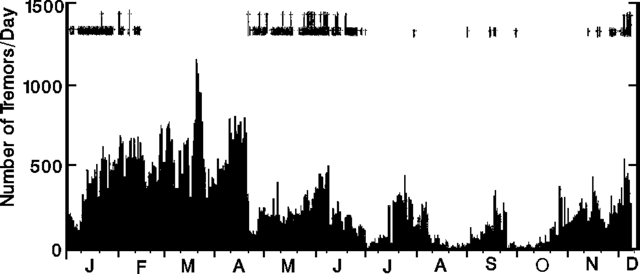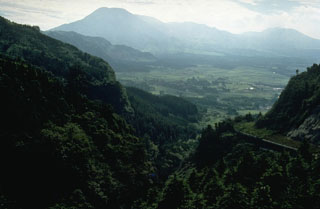Report on Asosan (Japan) — November 1990
Bulletin of the Global Volcanism Network, vol. 15, no. 11 (November 1990)
Managing Editor: Lindsay McClelland.
Asosan (Japan) Tephra ejection resumes
Please cite this report as:
Global Volcanism Program, 1990. Report on Asosan (Japan) (McClelland, L., ed.). Bulletin of the Global Volcanism Network, 15:11. Smithsonian Institution. https://doi.org/10.5479/si.GVP.BGVN199011-282110
Asosan
Japan
32.8849°N, 131.085°E; summit elev. 1592 m
All times are local (unless otherwise noted)
Crater 1, active July 1989-June 1990 (table 6), weakly emitted ash on 12, 18-19, and 25-29 November; white steam was emitted steadily on other days. The highest plume observed in November reached 1,000 m above the crater. Ash had last been emitted on 17 September. The area within 1 km of the crater, which had reopened to tourists on 15 October, was closed on 12 November and remained closed in early December.
Table 6. Brief chronology of activity at Aso, January-14 December, 1990.
| Date | Activity |
| Jan 1990 | Eruption continuing (since July 1989). |
| 07 Feb 1990 | Eruption ceased. |
| Mar 1990 | Quiet, but white steaming continued. |
| 20 Apr 1990 | Eruption resumed. |
| May-Jun 1990 | Frequent strong eruptions. |
| Jul-Aug 1990 | Quiet, with occasional weak ash emissions. |
| Sep 1990 | Occasional ash emissions; vent 901 opened. |
| Oct 1990 | Quiet; white steam; tremor increased toward month's end. |
| Nov 1990 | Ash emissions and glow resumed at mid-month. Stronger tremor continued through the month. |
| 13 Nov 1990 | Glow resumed on crater floor. |
| 17 Nov 1990 | Scoria ejection resumed. |
| 24 Nov 1990 | Vent 902 had opened; 811°C temperature measured. |
| 04 Dec 1990 | Eruption at 0410 ejected 1,200-m ash cloud. |
| 06 Dec 1990 | Eruption; vent 903 had opened. |
| 07 Dec 1990 | Eruption. |
| 08 Dec 1990 | Eruption. |
| 13 Dec 1990 | Eruption. |
Glow from many points on the crater floor was observed during a night visit on 13 November, the first crater glow seen since June. Glow remained visible through early December. During 17 November fieldwork, incandescent scoria was being ejected to 30 m height from a small vent on the crater floor. Scoria ejection had last been observed in June. By the 24 November crater visit, a vent 10 m across had developed on the crater floor and was ejecting blocks to 5 m height. The vent was named 902, the second new vent of 1990.... An infrared thermometer detected a maximum temperature of 811°C in the vent.
Ash emission became frequent in early December. An eruption on 4 December at 1410 ejected a 1200-m ash cloud, December's highest (as of the 14th), and similar activity occurred on 6, 7, 8, and 13 December. Vigorous ash emissions had last occurred in June. Ejections of blocks and scoria were also more frequent and higher (to 150 m) in early December. A visit on 6 December revealed that a new vent... had opened near 902.
The amplitude and number of volcanic tremor episodes has gradually increased since October and remained high through November (figure 19).
 |
Figure 19. Daily number of tremor events at Aso, January-8 December 1990. Longer arrows at top of figure mark eruptions, shorter arrows indicate weaker ash emissions. Courtesy of JMA. |
Geological Summary. The 24-km-wide Asosan caldera was formed during four major explosive eruptions from 300,000 to 90,000 years ago. These produced voluminous pyroclastic flows that covered much of Kyushu. The last of these, the Aso-4 eruption, produced more than 600 km3 of airfall tephra and pyroclastic-flow deposits. A group of 17 central cones was constructed in the middle of the caldera, one of which, Nakadake, is one of Japan's most active volcanoes. It was the location of Japan's first documented historical eruption in 553 CE. The Nakadake complex has remained active throughout the Holocene. Several other cones have been active during the Holocene, including the Kometsuka scoria cone as recently as about 210 CE. Historical eruptions have largely consisted of basaltic to basaltic andesite ash emission with periodic strombolian and phreatomagmatic activity. The summit crater of Nakadake is accessible by toll road and cable car, and is one of Kyushu's most popular tourist destinations.
Information Contacts: JMA.

